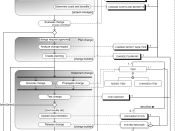Common Change Management Practices
The survey suggests that there are three types of change practices commonly implemented by overall respondents. They are "Business Expansion", "Work Process Change" and "Restructuring" - all over 50 per cent in frequency. The most common type of change was "Business Expansion," representing 72 per cent of the responses. Sixty-nine per cent of the respondents reported that they had implemented "Work Process Change" improvement projects in their organization, followed by "Restructuring" projects (54 per cent of responses). All respondents indicated that their organizational change efforts involved a combination of more than one type of change.
This result indicates that most manufacturing organizations are now facing severe business competition for survival. Efforts are being focused on market development or sales development in order to grow or maintain survival of their business. As market competition is now basically customer-driven and price-driven, it is imperative for organizations to make changes involving system and work processes, such as total quality management (TQM) and business process reengineering (BPR), and adding new computer systems, such as Enterprise Resources Planning (ERP), in order to improve productivity and challenge competitors anywhere in the world.
Initiators of Change
Respondents reported the three most active officers who frequently took initiative in implementing change efforts. They are "Managing Director" (74 per cent), "Division or Department Manager" (36 per cent) and "Chief Executive Officer" (31 per cent). The findings revealed that the managing director (MD) is the key person who usually initiated organizational change. It is interesting to note that most projects were mainly initiated by the managing director rather than division or departmental managers. This may suggest that the majority of change practices in Malaysia are a result of top-down management leadership. Even though total quality management (TQM) has been introduced in the manufacturing industry for years,


